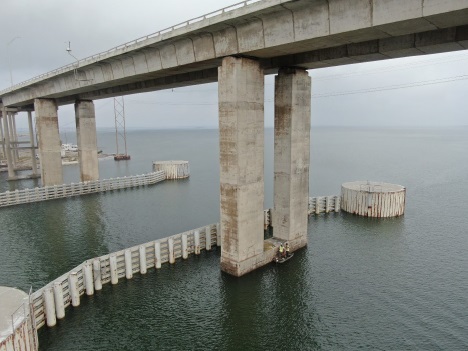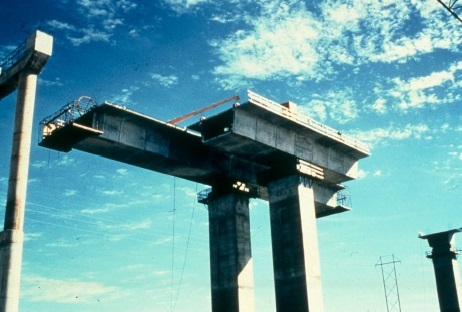JFK Memorial Causeway – Corpus Christ-Padre Island, Texas
The John F. Kennedy (JFK) Memorial Causeway Bridge, completed in 1973, carries Texas Park Road 22 over the Gulf Intracoastal Waterway (GIWW), connecting Corpus Christi to North Padre Island, Texas.
The original causeway was built in 1950 as a 2-lane toll road with swing bridges across two channels, and in 1973, it was converted to a 4-lane public roadway. Today, it consists of thirty-six prestressed concrete beam approach spans and a continuous three-span segmental unit over the GIWW. The total bridge length is 3,280 ft, and the width is 60 ft, carrying two lanes in each direction. The main span continuous unit was the first precast, post-tensioned (PT), segmental bridge built in the U.S. and was primarily designed by the University of Texas (UT) with an assist from the Texas Department of Transportation (TxDOT).
The project started with a TxDOT research project conducted in 1969 by John E. Breen, PhD, PE, of UT, to identify a viable concrete alternate to structural steel bridges in the 130- to 350-ft-span ranges. This project, Long Span Prestressed Concrete Bridges of Segmental Construction, State of the Art (0-121-1), identified segmental bridges as a viable candidate based on their studies of bridges recently constructed in Europe. TxDOT then extended UT’s contract to study other design and construction aspects of segmental construction in four subsequent studies—: Epoxy Resins for Jointing Segmentally Constructed Prestressed Concrete Bridges (0-121-2); The Design and Optimization of Segmentally Precast Prestressed Box Girder Bridges (0-121-3); Computer Analysis of Segmentally Erected Precast Prestressed Box Girder Bridges (0-121-4); Construction and Load Tests of a Segmental Precast Box Girder Bridge Model (0-121- 5); culminating with a final report, Minimizing Construction Problems in Segmentally Precast Box Girder Bridges (0-121-6F). Actually, the JFK Causeway was the second precast segmental bridge built because the first was the 1/6 scale model constructed and tested by UT for the 121-5 project. UT held several meetings with prospective contractors during scale model construction and testing to help them understand the challenges to be faced during construction.
For the contract documents, UT developed the specifications for the segment casting controls, epoxy- joining of segments, and stressing and grouting of tendons. UT also provided some construction oversight both in the casting yard and at the bridge site to supplement and train TxDOT personnel.
The segmental unit has a 200-ft-long main span over the GIWW, with 100-ft-long back spans for a total continuous unit length of 400 ft. The unit consists of a pair of segmental precast box girder sections that are 13 ft wide at the base, 28 ft, 8 in. wide at the wings, and 8 ft deep. The bridges are supported by two reinforced concrete columns at each interior pier, with the pier supported on large pile footings. The ends are supported on three-column transition bents.
The typical span segments were 10 ft long while the end segments and the pier segments were 5 ft long each. The precast segments included shear keys in each web to transfer vertical shear loads between adjacent segments and an alignment key in the top and bottom slabs at the box centerline to aid in segment alignment during erection.
Post-tensioning tendons, consisting of a varying number of prestressing strands, were threaded through metal ducts cast into the segments to hold the segments together and provide a minimum level of compression, under all service loads, over the full cross-sectional area of the box sections. During segment erection, cantilever tendons in the top slab were used to hold the segments in place as subsequent segments were erected. Once the full complement of segments was erected, a cast-in-place closure pour was made at midspan of the main span. Continuity tendons were threaded into metal ducts running from the deck down into the bottom of the box segment to produce a fully continuous structural unit. The pier hold-down bars were released and abandoned at this point.
The cantilever tendons were anchored in the box webs near the large shear keys and the continuity tendon anchors were located either at the end of the unit or in the top slab.
The precast segments were cast by PCI member, Heldenfelds Brothers Construction Corporation, at their Corpus Christi precast yard. The main unit was constructed by first erecting the two 5-ft-long pier segments on top of the reinforced concrete piers and engaging hold-down bars to temporarily connect the pier segments to the piers. The span segments were transported to the site and lifted into position using cranes and a custom-designed erection jig to hold the segments in place for application of the epoxy. The segment-mating faces were coated with epoxy before joining them together. The epoxy serves both as a lubricant when the segments are brought together, as well as a permanent joint seal between the precast segments. The span segments were erected on alternating sides of the piers so that the span remained no more than one segment out of balance at all times during construction—a process known as “balanced-cantilever construction.” The precast segments included large shear keys in each web to transfer vertical shear loads between adjacent segments and an alignment key in the top and bottom slabs at the box centerline to aid in segment alignment during erection. No permanent moment connection was made between the span and the main piers.
PT tendons, consisting of a varying number of prestressing strands, were inserted through metal ducts cast into the segments. The tendons were stressed to hold the segments together and provide a minimum level of compression under all service loads, over the full cross-sectional area of the box sections. During segment erection, cantilever tendons in the top slab were used to hold the segments in place as subsequent segments were erected. Once the full complement of segments was erected, a cast- in-place closure pour was made at the middle of the main span. Continuity tendons were inserted into metal ducts that extended from the deck down into the bottom of the box segment to produce a fully continuous structural unit. The pier hold-down bars were then released and abandoned. The cantilever tendons were anchored in the box webs near the large shear keys. The continuity tendon anchors were located at the ends of the unit and in the top slab.
Construction challenges for this new type of construction were to be expected. The contractor had substantial difficulty inserting some of the tendons and matching the actual and calculated elongations. High friction values were noted early on in this process. The difficulties were attributed to the contractor’s choice to use a relatively thin-walled duct material that was more susceptible to denying, pinching and kinking during fabrication. The contractor also elected not to use any duct stabilizing devices, such as inflatable rubber tubes, to internally brace the ducts during casting operations. They decided to address the friction issue by using a water-soluble oil to coat the tendons before inserting them into the ducts. This meant the ducts had to be flushed with water before grouting. Grouting was performed within 48 hours of stressing to protect against corrosion in the marine environment.
In a few cases they had significant difficulties inserting the tendons into the ducts. In one case reported, the tendon sock used to pull the tendons through the duct became entangled on a lip of duct and the force of the tendon unwound the spiral metal duct from the concrete and created a large blockage. The damaged spiral metal duct was removed, and the tendon was grouted in the affected segments without a duct in place.
Web cracking was noticed early on in construction as the segments were erected, and the negative moment (cantilever) tendons were stressed. These cracks followed the tendon path and were visible on the interior and exterior of the boxes. At this point all 84 segments had been cast so the project was halted while UT conducted a study of the cracks to determine their cause and impact on the structure. UT determined that there were three primary causes of the cracks, which did not show up in the original 1/6 scale model upon which the design was based:
- In many of the as-cast segments, reinforcing steel that had to be cut to place the anchors was not replaced or was only partially replaced, leaving the region around the anchors with less reinforcing than called for in the plans. These bars were always replaced in the model.
- The actual anchors used in the bridge were a cone-type anchor whereas the model had used a flat plate bearing type
- The spiral reinforcing in the model (considering its scale) was much more substantial than that used in the bridge
UT’s accelerated study concluded that the cracks did not affect the capacity of the bridge and they did/would not extend or grow under service load. TxDOT subsequently required the contractor to “Vee” and seal the cracks with epoxy on both the interior and exterior surfaces for corrosion protection.
In a recent (2020) condition assessment commissioned by TxDOT, Wiss, Janney, Elstner Associates, inc. (WJE) concluded that the bridge overall was in fair to good condition considering its age and location along the Gulf Coast, with only a few minor corrosion-related issues largely attributed to ineffective quality control during fabrication of the segments. The PT system was investigated closely and found to be in very good condition. The web cracking identified during construction has not resulted in any long-term performance issues. Although the documented grouting procedures included some practices that are no longer recommended—primarily flushing of tendon ducts and use of expanding admixtures—WJE identified no evidence of significant or systemic problems with either the installation or composition of the tendon grout.
Jury Comments
This project remains an iconic piece of history for our industry and was the first post-tensioned concrete segmental bridge built in the United States and is deserving of recognition for its innovation and impact to the segmental industry. The choice to explore and ultimately utilize a new technology, not yet done in the United States was groundbreaking. The research implemented on this structure, and continued research, condition assessments, and monitoring throughout the life of the structure, has served as key knowledge and inspiration to be disseminated to following generations of industry professionals and into the implementation of segmental bridges that followed in its footsteps. With it’s marine-exposure environment and the lack of corrosion-mitigating features included in its original design, the overall good condition of this structure demonstrates the durability and longevity of segmental bridge construction and the quality and care in the implementation of this specific bridge.
2023 ASBI Bridge Award of Excellence
Category: John E. Breen Segmental Innovation Award
(Special award category for historical projects that made significant contributions to concrete segmental technology.)
State:
Texas
Owner:
TxDOT
Owner’s Engineer:
University of Texas at Austin
Designer:
John E. Breen, PE, Ph.D.
Contractor:
HB Zachry Corporation
Construction Engineering Inspection:
TxDOT
Precast Producer:
Heldenfelds Brothers Construction Corp.





